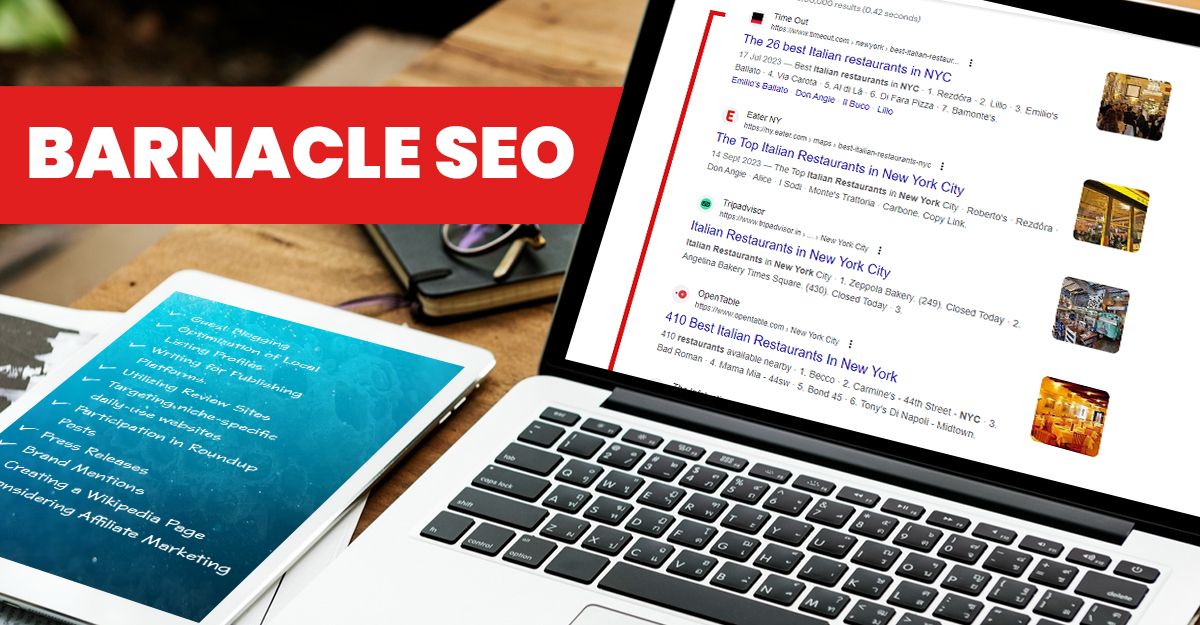Imagine you’re opening a bookstore in a bustling neighborhood. Rather than starting from scratch, consider partnering with an established bookstore nearby. By sharing space, you can tap into the existing customer base of the well-known bookstore, drawing attention to your new venture. This concept mirrors the strategy behind Barnacle SEO, where you leverage the popularity and authority of top-ranked websites to enhance your own online visibility.
Securing top rankings for every keyword can be a daunting task, requiring significant time and effort. This challenge is particularly acute for small or new businesses entering competitive markets.
Enter Barnacle SEO. In this blog, we’ll delve into what Barnacle SEO is, its origins, how it functions, and strategies to implement it effectively, thereby boosting your website’s visibility without the need for an overwhelming amount of effort.
What Is Barnacle SEO?
Barnacle SEO is the strategic practice of using the authority of high-ranking websites to elevate the visibility of your own brand, content, or products in searches for highly competitive keywords. This technique includes a variety of activities such as guest blogging, optimizing local listing profiles, engaging in review marketing, contributing to roundup posts, and earning brand mentions.
It’s crucial to recognize that the goal of Barnacle SEO is not to exploit the success of other sites but to mutually enhance the value and ranking potential of both your site and the host website. By aligning with reputable sites, businesses can not only drive more traffic to their own pages but also improve their organic search rankings. This method serves as a valuable complement to traditional SEO tactics, particularly when aiming to rank for competitive and broad keywords.
SEO service providers are harnessing Barnacle SEO to strategically attach their clients’ content to high-authority websites, amplifying visibility and driving targeted traffic.
The Term Barnacle SEO Came From
The concept of Barnacle SEO draws inspiration from the marine world, where barnacles, tiny arthropods often less than an inch in size, attach themselves to larger marine creatures such as whales. In doing so, barnacles benefit from the whale’s movements and stature in the ocean to access nutrients more efficiently, leveraging the whale’s significance without causing it harm. In 2008, the term “Barnacle SEO” was coined by search influencer Will Scott to describe a similar symbiotic strategy for smaller companies to boost their brand visibility by associating with well-established, high-authority websites.
By hitching their digital presence to sites that already rank well for competitive keywords, small or new businesses can achieve higher search rankings more easily than they might through traditional SEO efforts alone. This strategy encompasses a range of activities, including:
- Guest Blogging
- Optimization of Local Listing Profiles
- Writing for Publishing Platforms
- Utilizing Review Sites
- Targeting niche-specific daily-use websites
- Participation in Roundup Posts
- Press Releases
- Brand Mentions
- Creating a Wikipedia Page
- Considering Affiliate Marketing
It’s important to note that Barnacle SEO is not about exploiting the success of other brands. Like the relationship between barnacles and whales, which is commensal (barnacles neither harm nor benefit the whales), the goal is to form a mutually beneficial partnership with larger websites, adding value rather than acting parasitically.
Example of Barnacle SEO
Consider a scenario where your restaurant is struggling to compete for the highly sought-after keyword “Italian restaurant New York”. The top search results for such a keyword are often dominated by organic map listings, directories, and review sites rather than individual restaurant websites.
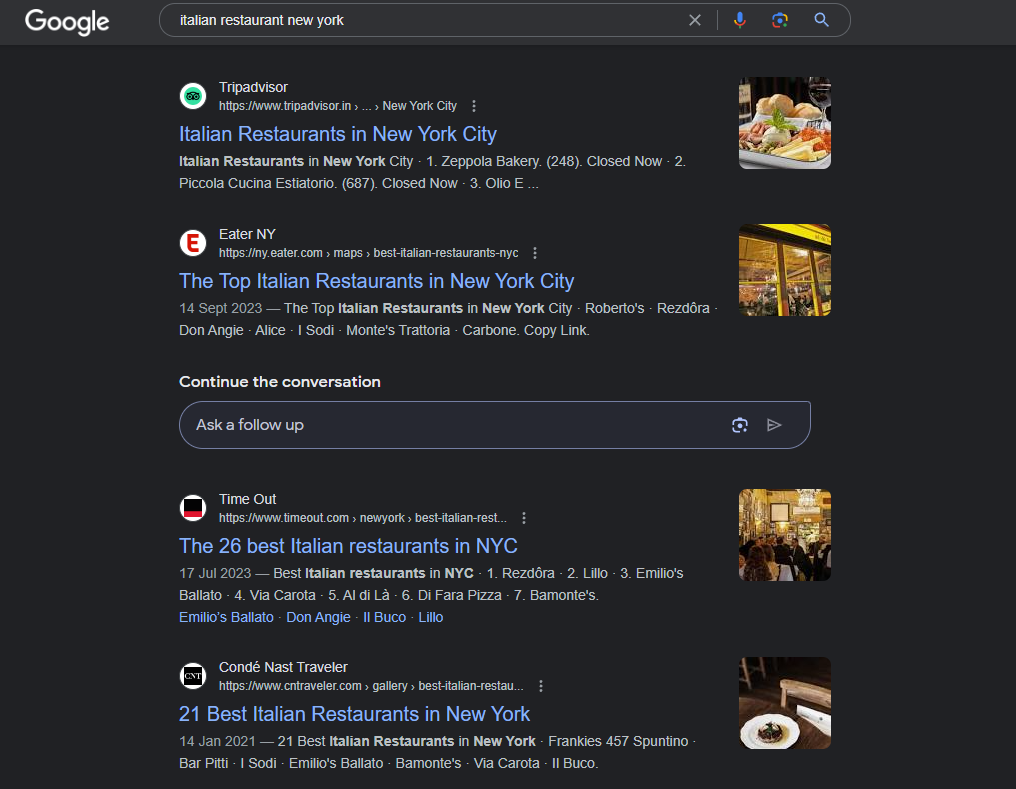
To enhance your restaurant’s online visibility and attract more customers, you can employ Barnacle SEO tactics such as:
- Listing your business on Google My Business.
- Sharing a photo from your anniversary catering event on various social media platforms.
- Contributing guest blog posts for a Top 10 anniversary meals round-up on relevant websites.
- Running anniversary catering campaigns through Instagram marketing or other suitable channels.
By adopting these strategies, your business can secure visibility on high-ranking third-party sites, circumventing the direct competition for your primary keyword. This approach can significantly improve your search ranking and bolster your brand’s reputation, particularly for small businesses that can benefit from visibility on local listing sites like Yelp.
Barnacle SEO vs. Classic SEO
Introduced by Will Scott, Barnacle SEO has gained prominence, especially in the context of local SEO listings. Previously, the main strategy for dominating local SEO was to perfect your website’s landing page optimization. However, the digital landscape has evolved, with Google map packs and review sites now playing a pivotal role.
Barnacle SEO represents a significant shift in this dynamic environment. Unlike classic SEO, which focuses on optimizing your own website, Barnacle SEO is about enhancing the performance of other, already successful websites.
The logic behind Barnacle SEO is simple: some websites already rank highly for competitive keywords, making it difficult for newer or smaller sites to compete directly. While it might seem counterintuitive for established brands to rely on other websites for visibility, Barnacle SEO offers a strategic advantage by targeting alternative or supplementary keywords, thus broadening your brand’s exposure and reach.
How to Conduct Barnacle SEO – Opportunity Research
Applying natural principles to SEO involves starting with basics like keyword research and extending to comprehensive backlink analysis.
Barnacle Keyword Research
Traditional keyword research often emphasizes the importance of targeting long-tail keywords with lower competition. However, Barnacle SEO takes a different approach, focusing on competing for highly competitive keywords where ranking might be challenging due to several factors:
Your website does not have sufficient authority
Gaining a top spot on the first Search Engine Results Page (SERP) isn’t always about your website’s inherent authority. While authority is critical in some cases, it’s important to evaluate each scenario individually.
For instance, consider a niche e-commerce platform specializing in personalized, handmade gifts. A product page on such a site might not accommodate extensive 3,000-word articles, posing a challenge in outperforming established competitors.
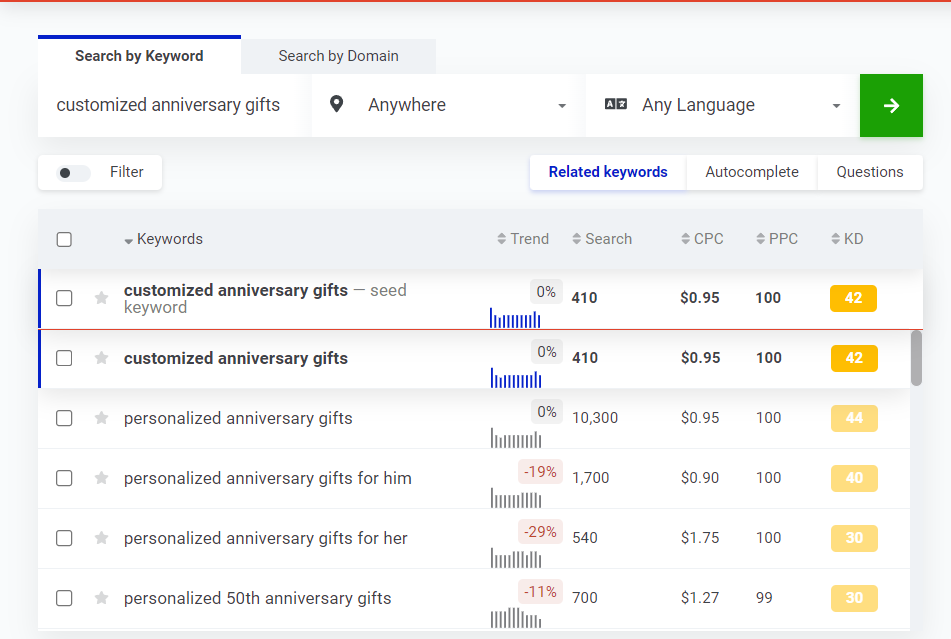
Take the keyword “customized anniversary gifts” as an example. Tools like KWFinder may show a high Keyword Difficulty, indicating a steep challenge for a new website aiming to rank for this term. Despite related keywords having significant search volumes, competing against well-established entities might prove daunting, and variations in search intent could affect relevance.
Analyzing the SERP for these keywords reveals their economic value, suggesting alternative strategies like Google Ads for overcoming ranking hurdles.
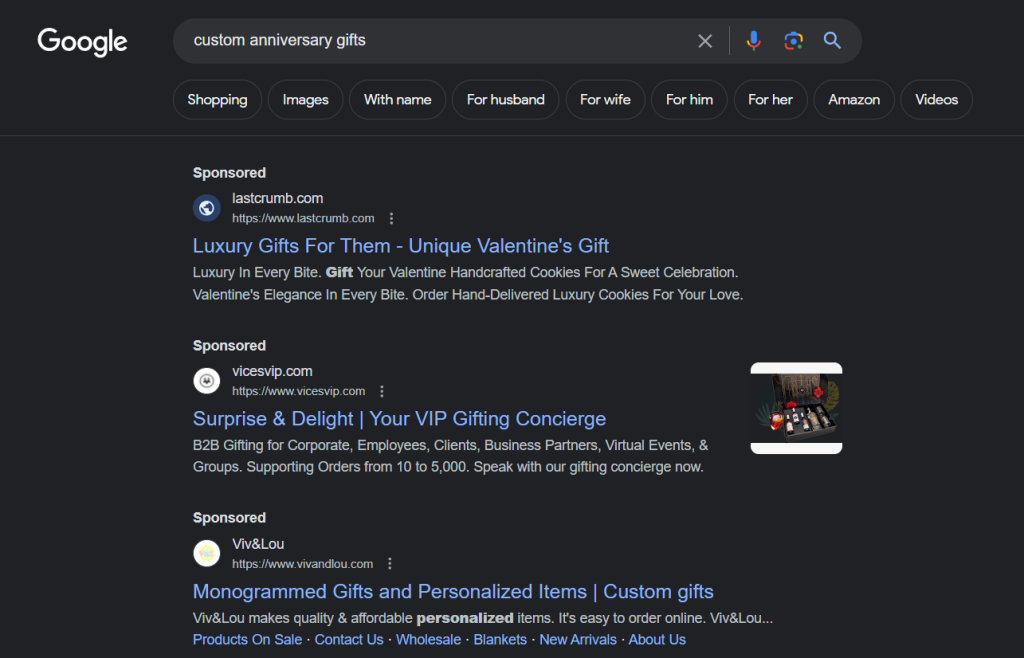
Moreover, gaining brand mentions on high-ranking sites can be advantageous. Establishing relationships with competitors and influential blogs or platforms that feature gift lists can provide opportunities to highlight your unique offerings.
The keywords are too unique, or they have a distinct search purpose
Consider a scenario with a small restaurant in Chicago aiming to rank for “best restaurants in Chicago.” Although securing a top spot in search results for such a popular query could significantly impact visibility, the search intent behind this term may not fully align with the specific offerings or goals of our restaurant’s website.
With a high search volume of over 33,900 and a Keyword Difficulty rating of 44, the challenge of achieving a high ranking is substantial.
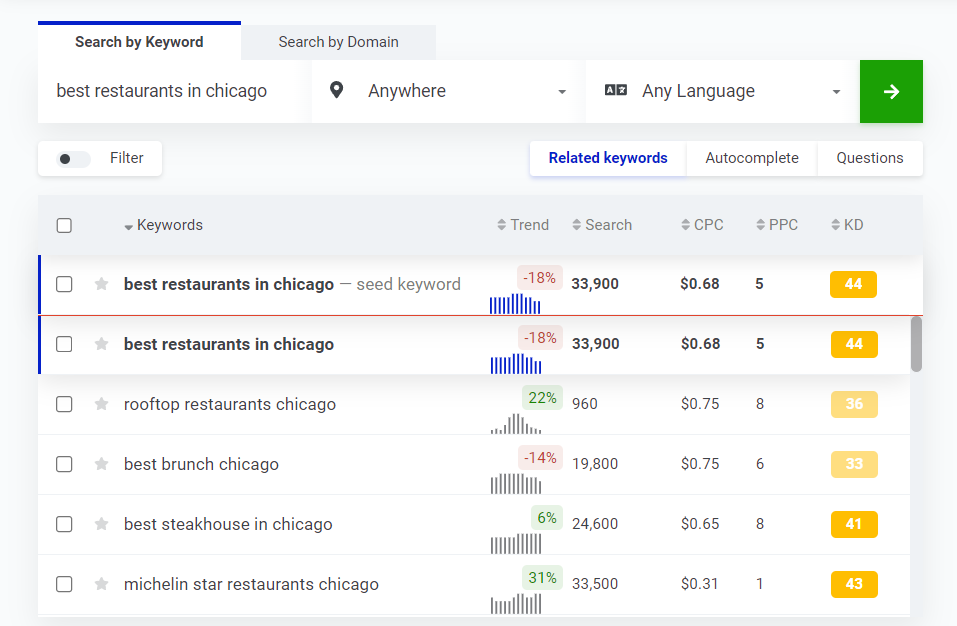
A closer look at the Search Engine Results Page (SERP) underscores these difficulties.
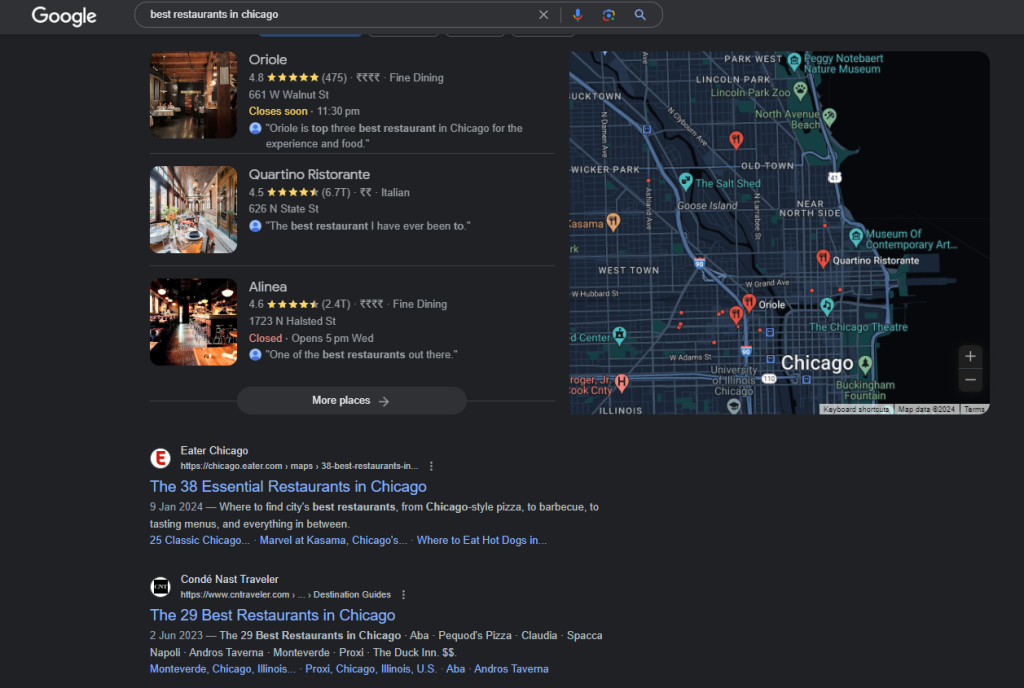
The SERP analysis further highlights the hurdles, particularly with map-pack type keywords, making it imperative to optimize our Google My Business profile. However, even with thorough optimization, securing a position in the top three amidst stiff competition is not assured.
In this context, Barnacle SEO offers a strategic pivot. By viewing potential competitors as collaborators, the opportunity to feature in curated lists becomes a viable avenue for enhancing our restaurant’s visibility.
You do not intend to commit your time and budget to accomplish so
Entrepreneurs are often confronted with the reality of opportunity costs. Even with an innovative product or service, starting a blog or engaging in extensive content creation may not be the most strategic move, especially when budget constraints limit the ability to hire experienced content creators. In such cases, the focus shifts towards seeking efficient SEO strategies that maximize return without extensive investment.
It is impossible to rank for everything
It’s a practical truth that ranking for every conceivable keyword is an unrealistic goal. A more strategic approach involves leveraging websites that already rank on the first page for desired keywords. By featuring your brand, discussing your offerings, securing reviews, or gaining mentions on these platforms, you can tap into their established audience, thereby expanding your reach with significantly less effort.
Also Read: 13 Best SEO Keyword Research Tools and Their Benefits in 2025
Barnacle SEO Techniques
Publishing Platforms
Platforms like Medium, renowned for their expansive reach across a multitude of topics from lifestyle tips to in-depth business insights, often feature prominently on search engine results pages with snippets and knowledge graphs. With a high Domain Authority of 95 and a low spam score, publishing on Medium and similar platforms presents a valuable opportunity for leveraging Barnacle SEO to target highly competitive industry terms.
To effectively utilize Medium for Barnacle SEO, follow these steps:
- Conducting accurate keyword research.
- Identifying the user search intent.
- Optimizing content to align with the target keyword.
- Incorporating subheadings, bullet points, and naturally including keywords.
- Adding creative elements such as images, infographics, and videos.
Exploring other reputable publishing platforms with strong Domain Authority (DA) and Page Authority (PA) can also amplify your content’s reach and credibility. For content classified as YMYL (Your Money or Your Life), adherence to Google’s E-A-T (Expertise, Authoritativeness, Trustworthiness) guidelines is critical to maintain trust and authority.
Also Read: How to gain local results with Google My Business?
Maximize the Benefits of Your Google My Business Listing
A well-optimized Google My Business (GMB) profile is a cornerstone of effective local SEO. Begin by claiming your GMB profile or creating one if necessary. Focus on keeping your business information, like address and opening hours, up-to-date. Enhance your profile further by adding high-quality images of your brand.
Actively encourage your customers to leave reviews and make it a point to respond to them promptly. Achieving a spot in the top 3 local search results can significantly enhance your visibility, making customer reviews and engagement vital.
Optimizing your GMB profile is not optional but essential for those aiming to secure a strong presence in local search results and attract a local customer base. This optimization is a key strategy in Barnacle SEO, improving your business’s local visibility and attracting a wider audience within your community.
Review Marketing
Navigating the landscape of online reviews is crucial for any business looking to enhance its digital footprint. A proactive presence on key review platforms can significantly bolster your online reputation, serving as a conduit for both organic and direct traffic influx. Start by setting up your business profiles on industry-relevant review sites such as:
- Google My Business
- TripAdvisor
- Yelp
- Amazon
- Angie’s List
- Foursquare
For those in the SaaS sector, platforms like Capterra, G2 Crowd, GetApp, Trustpilot, and Software Advice are invaluable. Additionally, sites like Clutch are especially pertinent for software businesses, showcasing top brand listings and reviews, as illustrated in the accompanying image. Leverage these platforms through a barnacle SEO lens by ensuring your profiles are comprehensive and include website links, thereby enhancing your online visibility and organic search presence.
Maintain up-to-date information across all review sites, detailing your business’s location, operating hours, and services. Enhancing your website’s user experience and navigation further amplifies this effect, solidifying a strong online persona and fostering positive customer perceptions.
Affiliate Marketing
Affiliate marketing centers on generating backlinks and driving traffic from individuals poised to make purchases. The allure of an affiliate program often lies in its simplicity and expediency; for instance, our program can be joined in moments without a review process, quickly becoming a key revenue stream.
Despite variances across industries, offering competitive commissions and providing comprehensive support for affiliates is paramount. Affiliates typically target high-intent commercial search terms, producing in-depth reviews, comparisons, and compiling lists of lucrative offers, such as:
- [Product/Service] reviews
- Best [Products/Services] Black Friday deals
- [Product A] vs. [Product B]
- Comparison of [Products/Services]
While this strategy might not directly target the most popular search terms, it effectively incorporates your brand into high-value content.
Consider the impact of a well-known influencer reviewing your product; such endorsements can significantly elevate your brand’s profile. A link from a high-authority site not only brings direct traffic but also uses the host site’s clout to improve your ranking for targeted keywords.
Craft content that thoughtfully integrates affiliate products or services, ensuring it adds real value for the audience while showcasing the advantages of your offerings. This approach not only elevates your brand but also enriches the content landscape of your affiliate partners.
Guest Blogging
Guest blogging stands out as an effective method for link building, perfectly aligning with the ethos of Barnacle SEO. The core concept involves identifying high-traffic websites within your niche, contributing articles that incorporate competitive keywords, and pitching your content to influential blogs to secure guest posts. This tactic effectively anchors your brand to established platforms, much like a barnacle attaches to a larger host.
For travel brands, initiating this strategy could start with targeted searches using phrases such as:
- “[Insert Niche] blog + guest post”
- “[Insert Niche] blog + write for us”
- “[Insert Niche] blog + submit a guest post”
This approach can uncover numerous opportunities for guest contributions within the travel sector, as illustrated in the accompanying image.
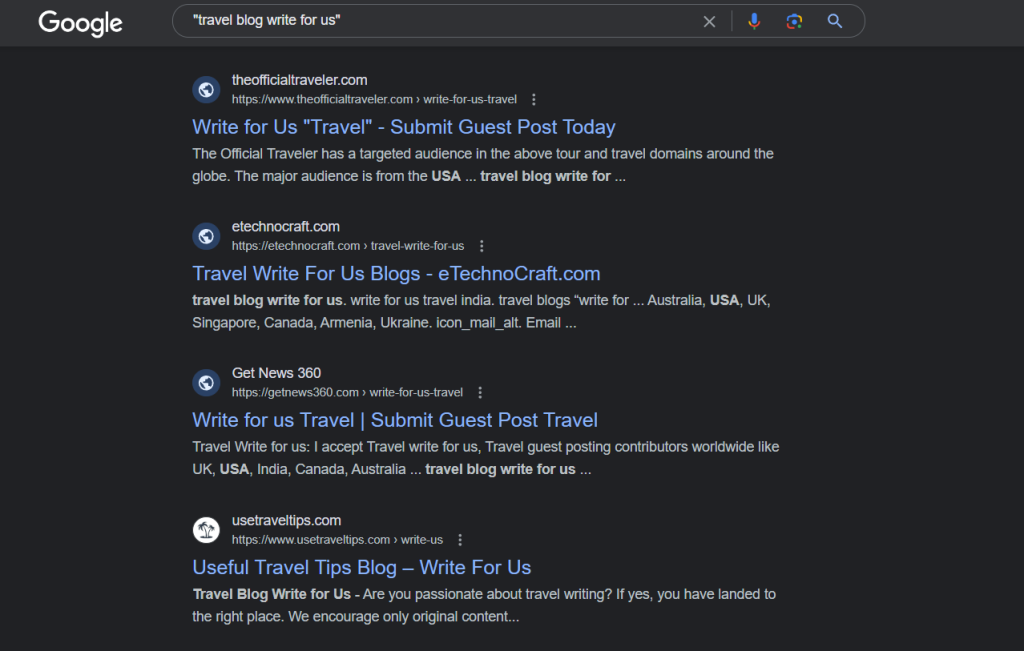
To avoid potential penalties from search engines like Google, it’s essential to approach guest blogging with caution. Focus on contributing only to reputable sites that maintain high editorial standards. This selective strategy ensures that your guest blogging efforts genuinely enhance your brand’s visibility, generate valuable leads, and avoid association with spammy practices.
Roundup Blog Posts
Roundup blog posts, known for aggregating insights from various industry experts, tend to be widely shared on social media, benefiting both contributors and readers. Partnering with a well-regarded authority site that consistently ranks high on SERPs can be particularly beneficial.
Even without targeted efforts, featuring in SEO roundups can draw additional attention to your brand. To leverage this strategy effectively, identify topics closely related to your business with substantial search volumes and gradually engage in creating roundup posts. This approach not only amplifies your online footprint but also cultivates industry relationships.
Target Top Lists
“Top 10” lists and similar compilations frequently appear in search results, offering a prime opportunity for visibility. If you’re promoting a product or running a local business, securing a spot for such competitive keywords on your own site can be daunting.
Refine your strategy by exploring the following types of keywords using a keyword research tool or directly in Google Search:
- Best {products/services}
- Top 10/20/… {products/services}
- List of {products/services}
Organize the findings and actively engage with the authors or platforms behind these lists. For instance, in promoting our beginner’s guide to SEO, titled “Learn SEO,” we targeted keywords like:
- Best SEO guides
- Top SEO guides
- List of SEO guides
- SEO guides
- SEO tutorials
- SEO guides for beginners
- How to learn SEO
Brand Mentions
Elevating your business profile on esteemed websites through reviews or roundup articles is a strategic move. One effective method to achieve this is by securing a feature in blog posts by renowned bloggers or influencers in your industry.
Such brand mentions are instrumental in amplifying your brand’s visibility and forging valuable connections with industry leaders. It’s essential, however, that any mention of your brand is relevant and adds value to the broader conversation.
Brand mentions are key to raising awareness and spreading the word about your services or products, aiming to capture the attention of the appropriate audience. Utilizing tools like Google Alerts can aid in tracking mentions of your brand, even in the absence of direct backlinks. Following up with website owners to suggest adding links where your brand is mentioned can be a proactive and effective approach.
Create A Wikipedia Page
Creating a Wikipedia page for your company can significantly bolster your online presence. With its high domain authority, Wikipedia is a powerhouse in search rankings, hosting millions of pages, including numerous corporate profiles. The most impactful Wikipedia pages are those that adhere to a neutral tone, cite credible sources, and provide an accurate depiction of the company.
Consider the Wikipedia page for Asana, the San Francisco-based software company, as a prime example of how to effectively present your company. Despite the potential for confusion with the software of the same name, the issue is addressed clearly right at the outset.
A Wikipedia page not only enhances your brand’s visibility, credibility, and reputation but also does so at no financial cost. Leveraging Wikipedia as a platform can significantly improve your business’s online footprint and solidify its standing in search engine results.
Press Releases
It’s essential to publish a post about a company on a news website or in a business newspaper and distribute a news release discussing current and essential matters.
Here are some guidelines for linking in press releases:
| Dos of Linking in Press Releases | Don’ts of Linking in Press Releases |
| Use descriptive, keyword-based anchor text for your links. | Use transactional or promotional language for anchor text and surrounding context. |
| Limit the number of links in your press release. | Feature the same link multiple times in your press release. |
| Follow the linking guidelines of the press release directories. | Link to irrelevant or low-quality pages or resources. |
To get your business featured on a news site or other industry publications, write a press release related to something relevant and topical. Distribute it to a PR distribution site, ensuring you have solid and sturdy content to increase the chances of publication.
Make Creatives
Diversifying your content with creative elements can significantly enhance its appeal and effectiveness. For instance, producing a video report for events or a detailed video guide on bike repair techniques can add substantial value, especially if shared with top-rated local bike shops. If there’s potential to elevate the content further, consider collaborating with the content creator or website owner to help boost their site’s ranking through enriched media.
Your business type doesn’t restrict the use of creative formats like videos, infographics, memes, or gifs. These content types are versatile and can be effectively integrated across various industries to engage audiences and convey information in an engaging manner.
Sponsored Content
Sponsored content involves a financial agreement with an online platform to feature your article, integrating your company’s branding in a way that feels organic to the audience. Despite the associated costs, this strategy can significantly enhance your brand’s visibility and reach, making it a worthwhile investment for expanding your online presence.
Social Media Platforms
While this article aims to steer clear of conventional marketing tactics often miscategorized as barnacle SEO, it’s worth examining how your brand can ‘attach’ itself to major social media platforms like Facebook, YouTube, Instagram, and Pinterest, embodying the barnacle SEO concept.
To amplify your social media endeavors, consider these strategies:
- Engagement Matters:
- Actively respond to the most engaging posts.
- Like or upvote content that aligns with your brand.
- Strategic Brand Mentions:
- Avoid spam, but take advantage of opportunities to subtly mention your brand, mainly through engaging videos or other compelling content.
- Community Building:
- Encourage and motivate others to participate in discussions on your content.
- Initiate discussions within the most popular groups and threads relevant to your brand.
- Diversify Content Creation:
- Develop high-quality, original content tailored for platforms like Reddit, Quora, or LinkedIn.
Remember, the higher the social engagement, the more impactful your efforts become. By implementing these practices, you not only leverage the inherent search capabilities of social networks but also cultivate a dynamic and influential online presence for your brand.
The Optimal Growth Strategy for Dominating the SERP
In an ideal digital landscape, your domain(s) should stand out prominently on search engine results pages (SERPs), showcasing relevant content without the need for private blog networks (PBNs).
During a keyword research session for a landing page, it was observed that SERPChecker appeared in the rankings for the targeted keyword. Additionally, a highly-ranked Medium article highlighted SERPChecker’s utility, and a guest post centered around the same keyword further contributed to the visibility. KWFinder also made its presence felt on the first page with a dedicated landing page for the term, thus populating the search results for “SERP analysis” with references to SERPChecker, as demonstrated below:
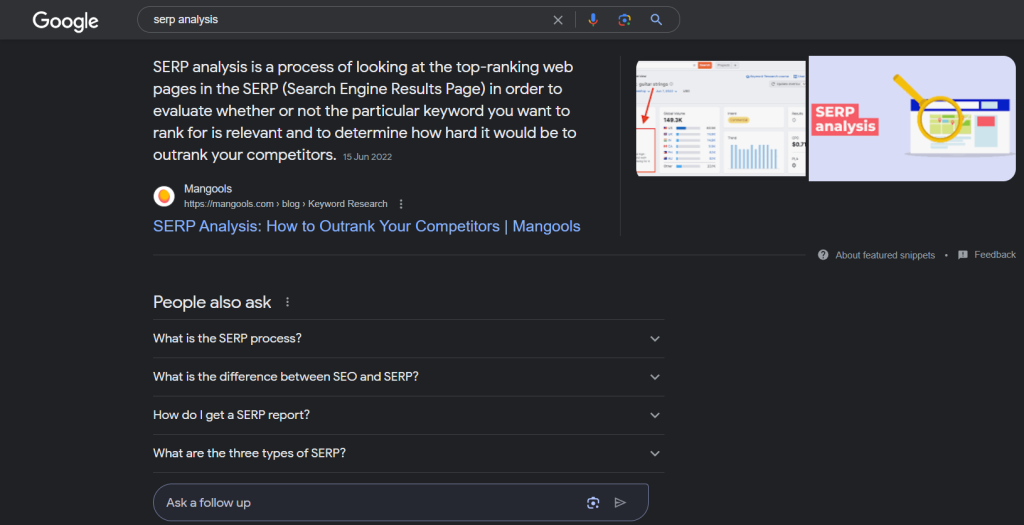
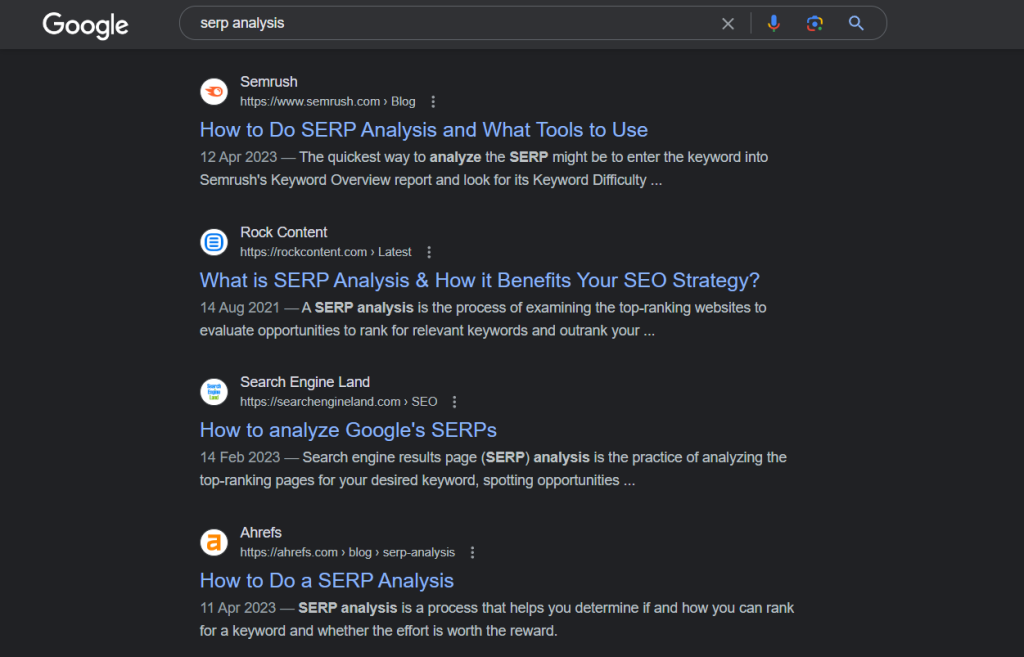
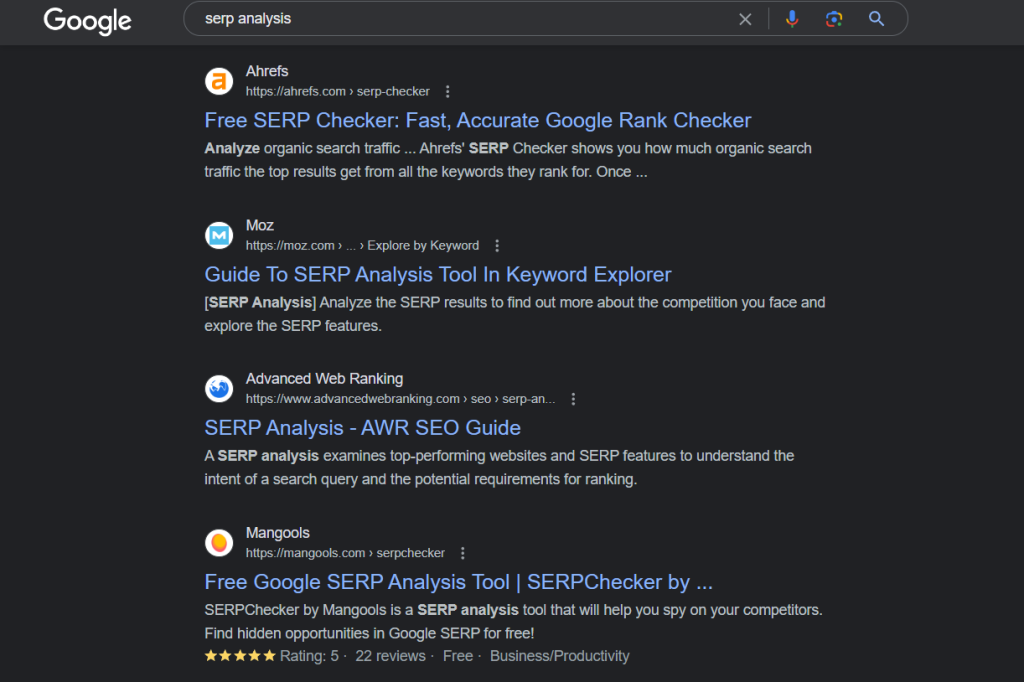
Promote Your Barnacles
To maximize the impact of your barnacle content, consider the following promotional tactics:
- Integrate links to them within your website, blog, or any guest posts.
- Actively upvote these links on relevant forums.
- Share these links across your social media profiles.
- Incorporate mentions of these links in your creative content.
- Engage with and respond to posts containing these links.
Enhance your monitoring efforts by utilizing tools such as Google Alerts or Mention for increased effectiveness.
Conclusion
Barnacle SEO presents a streamlined strategy for maintaining a strong online presence, particularly for small businesses operating on limited budgets. As Will Scott advocates, effectively leveraging Barnacle SEO can substantially aid in promoting small business websites by identifying and attaching to lucrative opportunities. This approach diverges from traditional SEO tactics like keyword research and backlink generation by focusing on enhancing the visibility of external websites rather than your own.
It’s essential to understand that Barnacle SEO is not about exploiting other sites. Rather, your contributions should aim to enrich these platforms, assisting them in achieving higher search rankings. The discussed strategies often involve link-building and marketing initiatives, viewed through the lens of Barnacle SEO, where optimization is applied to external websites, thereby creating new avenues for your brand’s exposure.
Moreover, Barnacle SEO can encompass activities such as sponsoring community events, engaging in influencer marketing, utilizing PPC advertising, and acquiring banner ad spaces. These tactics, while not exhaustively detailed here, form part of a broader Barnacle SEO framework.
FAQs
Why is it referred to as “Barnacle” SEO?
The term “Barnacle” metaphorically represents the strategy of attaching your brand to larger, more established entities, akin to barnacles latching onto ships, to leverage their established presence and traffic.
What types of content work well for Barnacle SEO?
Effective Barnacle SEO content can include blog posts, guest articles, business listings, and social media profiles, tailored to match the host site’s theme and audience.
How can I identify suitable websites for Barnacle SEO?
Utilize SEO tools such as Moz, Ahrefs, or SEMrush to identify high-authority sites in your niche. Look for guest posting opportunities, directory listings, or collaboration prospects.
Are there any risks associated with Barnacle SEO?
While Barnacle SEO is generally low-risk, dependence on external sites for visibility means you have limited control. Changes in their policies or algorithms could affect your brand’s exposure. Diversifying your SEO strategy can help mitigate these risks.
